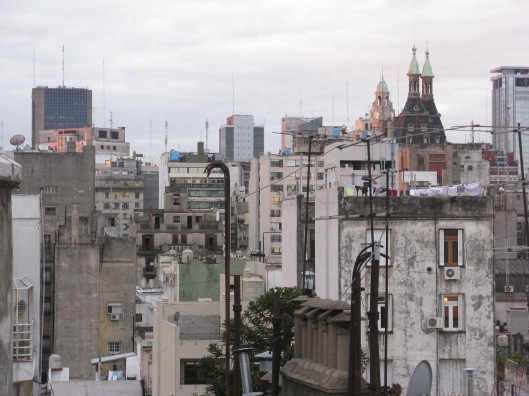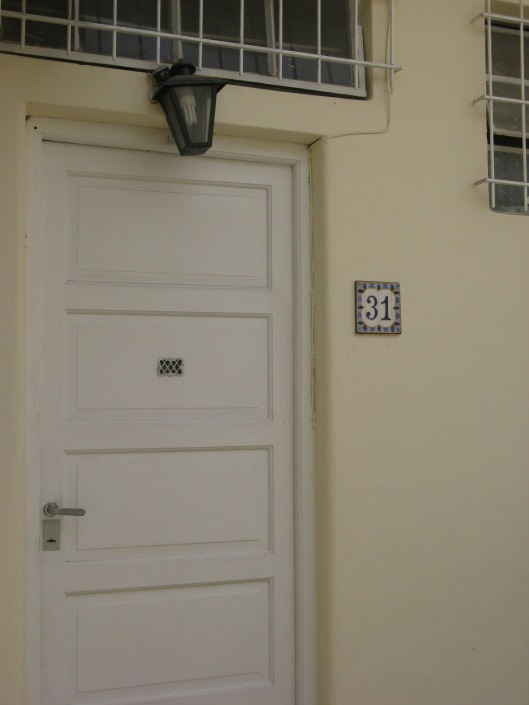The panelled door of the city mansion swings open and a man steps out onto the cracked pavement, cigarette drooping from his lips and newspaper folded in the crook of his arm. He hooks wire glasses onto his nose and murmurs a buen dia to the newspaper sellers across the street and to you as you wander past the kiosk. As the door creaks closed you catch a glimpse of not one room but a collection of misshapen coventillo apartments leading off a dusty alleyway, open to the bright blue sky. He saunters off towards the plaza to begin his day, the door locked on its hidden warren of sun-baked rooms.
This is his barrio; this is San Telmo, Buenos Aires. Spend some time here and you’ll come to look on it as yours, too. San Telmo is a proud neighbourhood with strong working-class roots. It captivates with its cobblestones and crumbling grandeur while surprising you with its rough, vivacious confidence. It is the barrio of seduction; the area of Buenos Aires most associated with tango. This dusty neighbourhood is made for wandering. San Telmo is the city’s oldest neighbourhood, bounded to the north by Avenida Chile and the south by Parque Lezama. San Telmo was part of the city’s first industrial area, home to windmills, brick kilns and warehouses and a brisk business exporting leather, wood and hides. It benefitted from renovation and improvements until a catastrophic yellow fever epidemic in 1871 changed its fortunes. Wealthy porteños fled the area and the city. Most of the grand mansions they left behind were cut up into coventillos, or tenement housing, for the immigrants that began to arrive in their place.
San Telmo is the city’s oldest neighbourhood, bounded to the north by Avenida Chile and the south by Parque Lezama. San Telmo was part of the city’s first industrial area, home to windmills, brick kilns and warehouses and a brisk business exporting leather, wood and hides. It benefitted from renovation and improvements until a catastrophic yellow fever epidemic in 1871 changed its fortunes. Wealthy porteños fled the area and the city. Most of the grand mansions they left behind were cut up into coventillos, or tenement housing, for the immigrants that began to arrive in their place.
 As a result, San Telmo became Buenos Aires’ most multi-cultural neighbourhood, housing the British, Italians, Russians and many others within its walls. Its cheap accommodation and liberal spirit also attracted artists and writers and San Telmo still retains a creative vitality. You’ll hear the samba beat before turning a corner to see the procession of drummers stamping and dancing down the street. Stop and listen to a folkloric melody from a guitar at the corner of the plaza. Walk past florescent street art peeling from the walls and step into an elegant apartment block for an evening of story-telling and electro-tango.
As a result, San Telmo became Buenos Aires’ most multi-cultural neighbourhood, housing the British, Italians, Russians and many others within its walls. Its cheap accommodation and liberal spirit also attracted artists and writers and San Telmo still retains a creative vitality. You’ll hear the samba beat before turning a corner to see the procession of drummers stamping and dancing down the street. Stop and listen to a folkloric melody from a guitar at the corner of the plaza. Walk past florescent street art peeling from the walls and step into an elegant apartment block for an evening of story-telling and electro-tango.
 This passion, this adventure that hangs in the air is suffused with the rhythm of tango. Tango is one of San Telmo’s major attractions. In 1968 Edmundo Rivero, a respected tango singer, founded the El Viejo Almacén (on the corner of Independencia and Balcarce), now just one of many tanguerías; bars and clubs dedicated to the art. Tango is the soul of San Telmo and it frequently spills out into its streets. If you’ve got only limited time, Sunday is the most rewarding day to visit. On Sunday evenings Plaza Dorrego hosts an outdoor milonga where, if you have the passion, your dancing skills will be welcome and you won’t be without a partner for long.
This passion, this adventure that hangs in the air is suffused with the rhythm of tango. Tango is one of San Telmo’s major attractions. In 1968 Edmundo Rivero, a respected tango singer, founded the El Viejo Almacén (on the corner of Independencia and Balcarce), now just one of many tanguerías; bars and clubs dedicated to the art. Tango is the soul of San Telmo and it frequently spills out into its streets. If you’ve got only limited time, Sunday is the most rewarding day to visit. On Sunday evenings Plaza Dorrego hosts an outdoor milonga where, if you have the passion, your dancing skills will be welcome and you won’t be without a partner for long.

 Earlier on Sunday the plaza is home to the Feria de San Telmo, a street market that cascades down Calle Defensa and into the surrounding blocks. If you’re not dancing there are many opportunities for shopping. Browse antique silverware, brightly painted filete artwork, jewel-coloured glass bottles and old advertising posters.
Earlier on Sunday the plaza is home to the Feria de San Telmo, a street market that cascades down Calle Defensa and into the surrounding blocks. If you’re not dancing there are many opportunities for shopping. Browse antique silverware, brightly painted filete artwork, jewel-coloured glass bottles and old advertising posters.
 A recent surge of gentrification – designer T-shirt shops and homeware boutiques have sprung up on many corners – may have altered its original character but it hasn’t totally extinguished San Telmo’s style. Spend time in its streets, in its dark panelled coffee houses and its tango bars and this barrio will seduce you. Soon you’ll want a key to your own latticed door, and the chance to wile away the hours sipping Malbec in the sunshine as the music dances through your own open window.
A recent surge of gentrification – designer T-shirt shops and homeware boutiques have sprung up on many corners – may have altered its original character but it hasn’t totally extinguished San Telmo’s style. Spend time in its streets, in its dark panelled coffee houses and its tango bars and this barrio will seduce you. Soon you’ll want a key to your own latticed door, and the chance to wile away the hours sipping Malbec in the sunshine as the music dances through your own open window.



This article about San Telmo was share on twitter with SANTELMER,
http://goo.gl/lnMoFK